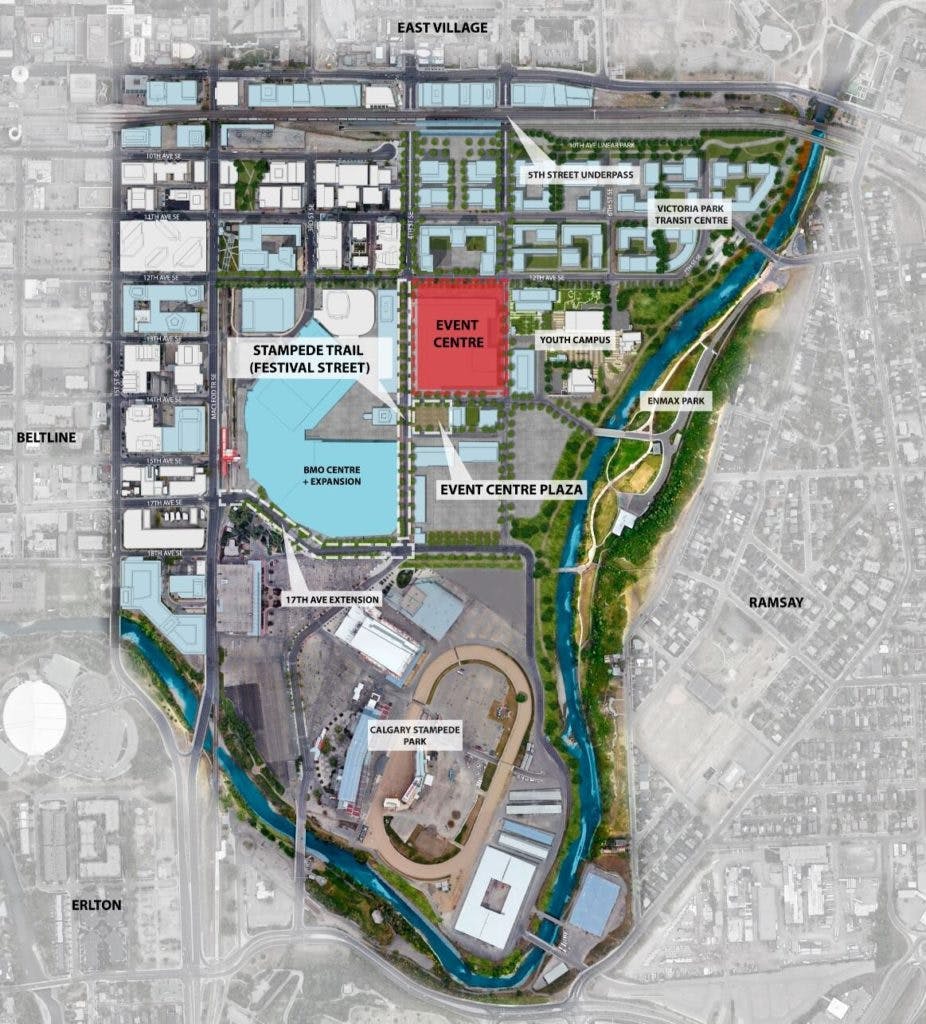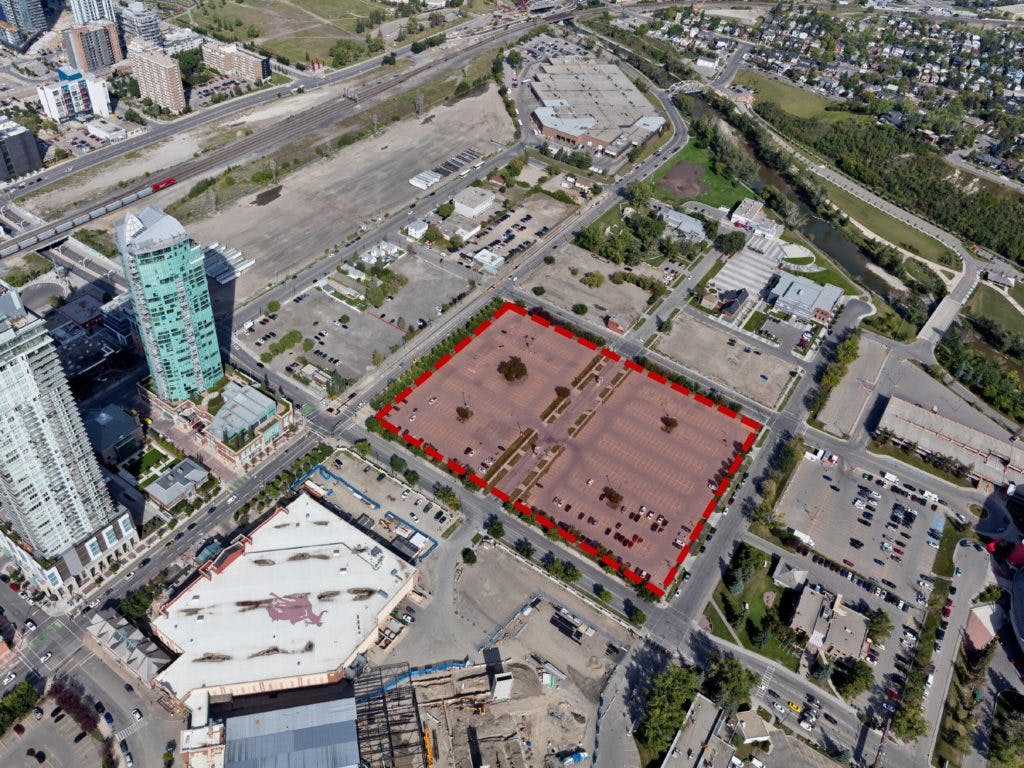Digging into the next steps towards Calgary’s new arena

By Ryan Pike
4 years agoBefore the holidays, the paperwork was all finally completed between the City, the Stampede and the Calgary Flames to finally get the arena deal done. Now comes the fun part: actually building the thing.
For some insight into what happens next, we had a chance to chat with Kate Thompson, the new president and CEO of Calgary Municipal Land Corporation – the city subsidiary that’s in charge of building the new arena.
(We’ve edited questions slightly for length and clarity.)
During the whole process, there seems to have been less vocal opposition for public support for the BMO Centre expansion than for the event centre – the link seems obvious, a bigger convention centre would draw in bigger tourist events. From a lay-person’s perspective, it seems like the value-add of the event centre investment would be getting people downtown more often or getting people down to the area that wouldn’t normally be downtown. Is that a fair assessment?
Absolutely. It’s complimentary. So they’re not exclusive and it’s not one versus the other which is the right investment. We really believe that it’s investment in the district and the overall area and if you have great things to come to – whether that’s a conference or a event or a concert or fantastic retail – it benefits all of the city, not just the district that we’re creating, but by having a healthy cultural and entertainment district you also have more visitors, you have more restaurant use, the spill-over effect, and that’s what our goal is.
The success of the East Village seemed to be from creating a critical mass of a bunch of different kinds of things. Calgary’s downtown life has been sporadic and nine-to-five, and planners have described the city’s activity as a “doughnut.” If done right, would the value of the district would be getting people to stick around after work and not just heading home after clocking out?
Our downtown I think over the last 10 years has gotten a lot better. I think a lot of that has to do with Calgarians asking for more and living differently, and the East Village has been able to capitalize on that and provide some great opportunities for Calgarians to do different things and kind of a different amenity – it’s a whole new island that’s been updated and renovated. We’ve got some cool restaurants down here and places to live near downtown, and people are reacting to that. It’s attracting different businesses. It’s attracting people who want to live and work in close proximity, so I think it’s becoming a destination.
What lessons can you take from the East Village experience? The redevelopment seemed like a tall order, in that the area seemed pretty stagnant and downright scary at times.
Our big lessons that we learned here are connectivity. The East Village was viewed as stagnant and not a lot happening, but when we started connecting it and we brought in riverwalks so there was a pedestrian safeway and a nice big open walkway for runners and bikers to come along, and then we had the Fourth Street underpass and then we have the two bridges – into Inglewood and onto the island and into Bridgeland.
Connections and opening up the district was really key for us in East Village and the same principle applies for our Rivers District Master Plan, which means opening up the connection with 17th Avenue, opening up Stampede Trail carrying up north through East Village, and then another underpass (Fifth Street underpass), all the connections with the riverwalk extension down into Stampede Park. So all of these lessons that we learned in East Village about increasing connectivity are huge for the Rivers District.

The investments into the Saddledome from different groups back in the ’80s didn’t amount to much build-out around it – it’s still a building surrounded by parking lots – but it seems that the partnerships are in place with all these deals for the arena and the BMO expansion that weren’t there before.
I think the key to our success is partnerships. So we first had a Memorandum of Understanding with the Stampede – that was a big step for Stampede, to say ‘Hey, there could be a group out here that does development and could help work with us to see the vision.’ They were the first ones who stepped up and said ‘Let’s work on a master plan for this district.’ And we did. And so that partnership led also to the event centre discussions with the partners at the city and the Stampede. Right now we have a preferred development partner for a hotel for a convention hotel. None of this is done, like any good business, it’s not done in isolation. You have to reach out and capitalize on your partners’ strengths and that’s really fundamental to the success of the district.
What happens next? The date we saw was for a Summer 2021 groundbreaking, but we imagine there’s a lot of stuff that has to happen in the interim.
Right now what we’re doing is we’re doing a really fast and open call to figure out the team – to hire the architects, the structural, mechanical, electrical engineers, the construction managers. The prime design consultant RFP is in the market now, we’ll have selected them by March along with our construction manager. We’ll have the full team ready to go and start designing, which means that can really start digging in and figuring out what this thing looks like, how it functions, the parameters, how to deal with all the site opportunities. Then we start vetting the design, and the costing and everything else, and then we get into the ground. There’s a lot happening over the next few months.

When do we think renderings of the design will be out?
Not until next year. The renders will be out next year… They have a lot of due diligence to understand what we can do on the site. A big thing for CMLC is what we can afford and what we can deliver on. My big message is always let’s put out a render – because rendering looks so real to life, it looks like you can build it the next day and start moving in – I want to put out a rendering that we can deliver on. I want to make sure that Calgarians know that when we put out a render, that it will be something that you’ll recognize it when it actually gets built. To do that, you have to make sure that you have the pricing right, the program right, know what you’re putting in there, and all the requisite pieces in line.
Since there’s been a flurry of sports venues built over the last 10 years, does the fact that there’s some good examples of what these different lead architects can do out there in the world make life easier for the vetting process? (And it’ll be easy for Calgarians to look up the designers, when they’re chosen, and wrap their heads around what they can do here?)
I think they’ll be able to see a track record of the successful firm or firms. I think what we all acknowledge is there are some great examples out there – we’re going to be looking at a few of them together with the successful team as well. But what’s interesting to us is there’s no one example out there that we want, the exact building. Because a building should be a function of its site, its constraints, its budget, all the rest. So when we evaluate a team, we’re really looking for A: do you have the experience, what have you worked on before?, but also B: how are you going to approach this project and do it differently than your other projects? We’re selfish, we want it to be better than the other projects. We consider the other projects good lessons learned, but now let’s apply those lessons and see what we can do differently in Calgary.
I know the concept of a $550 million project can seem big it’s easy to be skeptical about the scale of these things – they can be beasts. Does CMLC’s past involvement in things like Studio Bell and the Central Library developments during the East Village process – they’re cool-looking projects that really seem to be key drivers – lead to some confidence in taking on this project?
We’re working on these really amazing community-building projects because of our reputation. Our reputation is built on how we approach work, and how we approach work is every project is a complex beast, as you say, and we break it down into component parts. What are the goals? How do we meet those goals? How do we stay within our means? And how do we deliver? I’ll tell you there’s always issues on every project. Every single project, it doesn’t matter. If you’ve done a kitchen renovation you know there’s issues on that scale of project, too. It’s no different when you have a $500 million budget. There will be issues; it’s how you lay the groundwork and approach the project, have clear communication, clear goals and clear expectations.
We know they’ll be bumps in the road ahead and we’re prepared for them, but we’re also prepared to meet and exceed expectations of our partners.
Groundbreaking is tentatively scheduled for July or August 2021. “Substantial completion” of the building is slated for April 2024, with the mindset of having a summer’s worth of events to wok the kinks out before the beginning of the 2024-25 Calgary Flames season.
Recent articles from Ryan Pike





